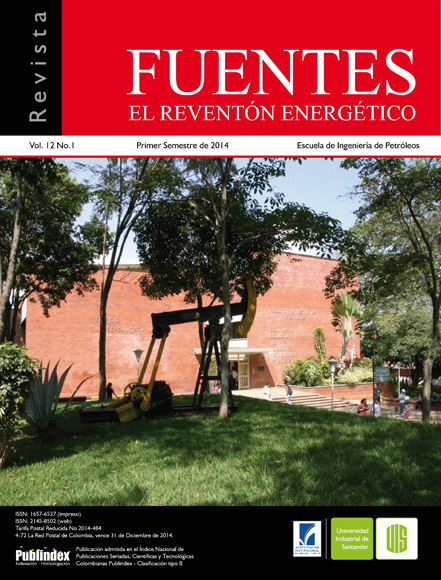ESTUDIO TÉCNICO-FINANCIERO PARA LA VIABILIDAD DE UN TRATAMIENTO DE FRACTURAMIENTO HIDRÁULICO EN CAMPO ESCUELA COLORADO
Published 2014-08-22
How to Cite
Abstract
RESUMEN
El objetivo del trabajo es presentar la evaluación de factibilidad de realizar un trabajo de fracturamiento hidráulico en pozos de Campo Colorado. Para tal fin se consideró que para que un tratamiento de fracturamiento sea exitoso se deben cumplir dos criterios: que la fractura sea técnicamente ejecutable y económicamente viable.
Mediante un modelo de producción se seleccionaron los pozos que presentarían mayor potencial al disminuir el daño en cara de pozo. Posteriormente se realizó la evaluación técnica mediante la caracterización geomecánica de la formación la cual permitió establecer: presión de poro, propiedades mecánicas y esfuerzos. Se seleccionaron los intervalos a intervenir con ayuda del modelo petrofísico. A estos intervalos se le evaluó la factibilidad de generar una fractura hidráulica mediante la determinación del tipo de falla inicial de la roca, presencia de barreras de contención de altura, gradiente de fractura y contraste de propiedades mecánicas.
Mediante la metodología del diseño unificado de fractura se diseñó la geometría óptima de fractura la cual maximizaría la productividad el pozo. Este potencial incremental de diseño fue utilizado para evaluar la viabilidad económica del tratamiento de fracturamiento el cual permite establecer si la inversión inicial y el costo operativo del tratamiento son recuperables durante el tiempo del tratamiento.
Palabras clave: Fracturamiento hidráulico, Diseño unificado de fractura, Modelo geomecánico, Propiedades mecánicas, Contraste de esfuerzos, Criterio de falla.
STUDY OF VIABILITY TECHNICAL- FINANCIAL FOR A HYDRAULIC FRACTURING TREATMENT IN COLORADO FIELD
ABSTRACT
The aim of this paper is to present the evaluation of feasibility of hydraulic fracturing job in Colorado Field wells. For this reason, it was considered for a hydraulic fracturing treatment in Colorado’s wells to be successful you must fulfill two criteria: the fracture has to be technically enforceable and economically feasible.
With a production model there were selected the Wells that presented greater potential to reduce the damage in the wellbore. Later the technical evaluation was made by geomechanical characterization of lithological column which allowed setting: pore pressure, mechanical properties and stress. Intervals were selected to intervene using the petrophysical model. Within these intervals it was evaluated the feasibility of generating a hydraulic fracture by determining the type of initial failure of the rock, presence of high containment barriers of height, fracture gradient and contrast of mechanical properties.
According to the Unified Fracture Design methodology it was designed the optimum fracture geometry which maximizes the well productivity. This potential incremental design was used to evaluate the economic feasibility of fracturing which allowed to establish whether the initial investment and operating cost of treatment were recovered during the treatment time.
Keywords: Hydraulic fracturing, unified fracture design, geomechanical model, mechanical properties, stress differences, faulting criterion.
